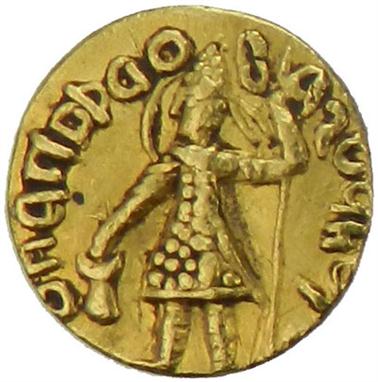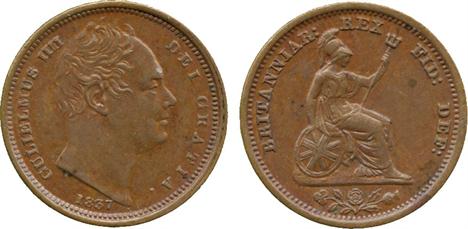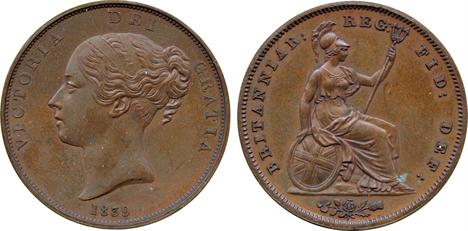We found 5411 price guide item(s) matching your search
There are 5411 lots that match your search criteria. Subscribe now to get instant access to the full price guide service.
Click here to subscribe- List
- Grid
-
5411 item(s)/page
An Arts and Crafts steel and brass toasting fork by Ernest Gimson (1864-1919) of trident form with hinged hand guard decorated with banded geometric design, the fork section terminating in a flattened loop handle, c. 1905, 40.5cm long Note:See Carruthers, A., and Greenstead, M., 1999 'Simplicity or Splendour, Arts & Crafts living: Objects from the Cheltenham Collections', Cheltenham Borough Council fig.61, for a similar example
Four 19th century transfer printed circular plates, depicting maritime scenes, to include 'East Indiaman sailing from the Downs', 'East Indiaman taking a Pilot On Board', diameter 23cm each, 'Frigate Setting Sail', diameter 25cm, a four masted ship in stormy sea set above Zeus's head and Trident with cannon and swords, impressed indistinct factory marks to base possibly Swann, diameter 23cm
Greek Parthia - Orodes II - Portrait Drachm57-38 BC, Ecbatana mint. Obv: bust left with pointed beard, wearing diadem and griffin-ended torque; wart on forehead, star at top right, crescent above star at top right; border of dots. Rev: BASILEWS BASILEWN ARSAKOY FILOPATOROS DIKAIOY EPIFANOYS FILELLHNOS legend in seven lines around beardless archer seated right on throne, wearing bashlyk and cloak, holding bow in right hand; behind archer, anchor with trident-like attachment on top (anchor type A48iii); PAT monogram beneath the bow. Sellwood 48.8; BMC 195-198; Sear 7445. 3.73 grams. [No Reserve]Very fine, off centre strike.Starting Price: £5
Greek Bactria - Antimachos I - Portrait TetradrachmCirca 174-165 BC, Pushkalavati mint. Obv: draped bust right, wearing kausia. Rev: BASILEWS QEOY ANTIMAXOY legend, Poseidon standing facing, holding trident and palm branch; DY monogram at lower right. SNG ANS 275; MIG 124f; Sear 7548. 15.50 grams. Very fine and better with slightly porous surfaces.Starting Price: £580
Greek Indo-Greek - Azes II - Tetradrachms [2]Circa 35 BC-5 AD. Obvs: BASILEWS BASILEWN MEGALOU AZOU legend, Emperor on horseback right, holding whip and raising right hand, bow on his back; upper coin with pra in right field, lower coin with de. Revs: upper coin: Poseidon standing right, holding trident and extending right hand, Whitehead monogram 27 to left, Karosthi letter si to right; lower coin: Zeus standing left, holding sceptre and Nike. Whitehead monogram 12 to left, Karosthi letter bu to right. Whitehead 177 (top); Whitehead 104 (bottom); see Wildwinds.com (these coins). 19.45 grams (total). [2]Extremely fine.Starting Price: £250
Anglo-Saxon Crondall Series - Witmen Derived - Gold Shilling (Thrymsa)Circa 620-640 AD, Kent (Canterbury?). Obv: profile diademed bust right with three ties and trident before. Rev: cross fourchee with blundered legend, letters retrograde and inverted. S. 753; N. 25; Sutherland IV.ii; M (1). 21, plate 1. 1.32 grams. The Crondall group comprises twelve English gold shilling (thrymsa) types represented in the famous Crondall, Hampshire, 1828 hoard (ex Lord Grantley collection and now preserved intact in the Ashmolean Museum, Oxford). The `Witmen` type is named from those with the WITMEN MONITA legend and this is usually seen blundered or in abbreviated forms. The type was almost certainly struck in Kent, possibly at Canterbury.Very fine, extremely rare (most in museums).Starting Price: £3000
KUSHAN: Vasu Deva I, ca. 191-230+, AV stater (8.03g), Mitch-3385, king standing, nimbate & helmeted, offering at the altar & holding a trident / Siva & bull, with Siva also holding diadem & trident, superb bold strike, choice Extremely Fine. The type with only one trident on obverse was probably struck relatively briefly at the commencement of his reign, followed by the more common type with a second trident above the altar, struck during the latter portion of his reign, and posthumously in increasingly stylized versions. Starting Price: $750 View image on stevealbum.com View 2nd image on stevealbum.com
KUSHAN: Vasu Deva I, ca. 191-230+, AV stater (7.98g), Mitch-3388, king standing, nimbate & helmeted, offering at the altar & holding a trident, second trident above the altar / Siva & bull, with Siva also holding diadem & trident, lovely bold strike, choice Extremely Fine. This type, with 2 tridents on the obverse, was struck during the middle and later years of Vasu Deva`s reign. It was formerly assumed that the single trident type belonged to a Vasu Deva I, the double trident to a postulated Vasu Deva II, but it is now generally accepted that both types belong to the same Vasu Deva, the first. Starting Price: $680 View image on stevealbum.com View 2nd image on stevealbum.com
A fine Charles II ebony table clock. John Knibb, Oxford, of ‘phase III’ design circa 1685-90. The fully latched twin fusee movement with typical Knibb pattern baluster turned pillars, verge escapement and striking the hours on a bell via a crossed-out numbered countwheel mounted to the rear of the movement, the backplate engraved with tulips and symmetrical scrolling foliage incorporating signature John Knibb, Oxon Fecit in a downward curve toward the lower margin, the 7 inch square gilt brass dial with calendar aperture to the finely matted centre within applied silvered Roman numeral chapter ring with trident half hour markers and Arabic five minutes within the narrow outer track, with fine sculpted blued steel hands and angles applied with gilt winged cherub head spandrels with engraved repeat signature to lower margin, the ebony veneered case with typical Knibb pattern foliate-bud tied hinged gilt brass carrying handle to the domed caddy surmount above moulded cornice and foliate scroll pierced lozenge sound fret to the upper rail of the front door, the uprights with cherub head and scroll cast gilt mounts (the left hand pivoted to reveal keyhole), the sides with rectangular side windows, on moulded shallow skirt base, 33cm (15ins) high excluding handle; with a foliate engraved and pierced brass winding key. John Knibb was born in 1650 and was apprenticed to his older brother, Joseph, in around 1664. When Joseph moved to London in 1670 to set up business (presumably in the workshop inherited from his uncle, Samuel) John, his younger brother, took on the Oxford workshop gaining the Freedom of the city on payment of a fine in 1673. Joseph Knibb retired in 1697 selling up most of his workshop before moving to Hanslop, Buckinghamshire where he made a few clocks prior to his death in 1711. John Knibb became a high profile figure within the City of Oxford twice becoming Mayor, he continued in business until his death in 1722. Due to the comparative rarity of clocks signed by John Knibb it has been suggested that his workshop may have generally served to supply Joseph’s larger concern in London. The strong similarities between John’s best work and those signed by Joseph would certainly support this view. However it is also clear that John was a high profile tradesman in the City of Oxford who trained no less than ten apprentices, therefore it is perhaps more likely that, although the two workshops were closely connected, they generally worked separately to supply clocks to differing groups of clients. The current lot is an quintessential example of a Knibb ‘phase III’ table clock with the movement possessing many typical features including distinctive baluster-turned movement pillars, crossed-out countwheel, signature in a downward curve to the foliate engraved backplate and finely sculpted blued steel hands. The case with its shouldered tied foliate-bud gilt brass handle, cornice with mouldings to underside only and winged cherub head mounts to the front door is also unmistakably Knibb in its design and detailing. All these details can be directly compared with an example by John Knibb of Oxford which sold at Christie’s King Street Magnificent Clocks 15th September 2004, Lot 38 for £44,212
AUTOGRAPHS. An autographed British Airways postcard signed by Neil Armstrong and Patrick Moore, circa 1974 (105 x 150mm.). Provenance: obtained by the vendor, a crew member in charge of Trident aircraft BA Charter, Flight 351, between London Heathrow and Glasgow, where the two would attend the Westclox factory seminar promoting the introduction of Quartz time-keeping.
An IOC session badge for the London meeting in 1939, gilt-metal & enamel, Britannia holding the Olympic Rings aloft with her trident, inscribed IOC LONDON 1939, XXXVI MEETING, ribbon suspension, brooch fitting; sold together with an unidentified enamelled badge also from 1939, inscribed 1939, MONACO, J U I., surmounted by Olympic Rings At the 1939 IOC Session in London Garmisch-Partenkirchen were selected to host the 1940 Winter Olympics and Cortina d’Ampezzo would do so in 1944. London was selected to host the Summer Games of 1944. All of course were cancelled upon the outbreak of the Second World War and all international Olympic business was suspended indefinitely.
STATUETTE en bronze de patine brune, représentant la déesse Durga, en pied sur une terrasse quadrangulaire décorée de pétales de lotus, sur fond d`une mandorle stylisée de flammes, à huit bras pourvus d`attributs, terrassant le démon-buffle Mahisha au moyen d`un trident. (Petits manques). Népal, XVIIIe siècle. Haut. 13,3 cm, H. 5 1/4 in. A bronze figure of Durga, Nepal, 18th century.
Title Pages (Atlas Novus Terrarum Orbis Imperia, Regna et Status Exactus Tabulis Geographice Demonstrans), Homann, Nuremberg, ca. 1710. 11 x 19”. (HC) This boldly engraved sheet has many allegorical figures gathered in front of a large globe. Standing atop the globe, Atlas and Hercules hold up the heavens. In the background, bats and owls fly in the night sky while storks and eagles fly toward the sun. In the forefront is Neptune, god of seafaring, with his trident. To his right are Mercury, with winged helmet and caduceus, and Cybele, goddess of cities, representing civilization. Behind Cybele is Aeolus, god of the winds. Engraved by Caspar Luyken. Ref: Shirley no.79. Lovely color with one tiny hole at lower left, a few unobtrusive spots, a vertical crease and marginal soiling. The left-hand margin has been extended to better accommodate framing. (+B)
Europe (Europa Recens Descripta), Blaeu, Amsterdam, ca. 1645. 21.8 x 16.3”. (HC) This classic map of Europe is presented in the carte-de-figures style with vignettes on three sides. The upper frieze has nine bird`s-eye views of Amsterdam, Prague, Constantinople, Venice, Rome, Paris, London, Toledo and Lisbon. The side borders contain the costumes of the noblemen and women of ten European nations. The map is embellished with sailing ships, sea monsters, bears and Neptune riding a dolphin and holding his trident. A beautiful map produced at the height of the Golden Age of Dutch mapmaking; it was included in the first volume of Blaeu`s magnificent atlas. French text on verso. Ref: Goss (Blaeu) no.4, p.30. Lovely color with a professionally repaired centerfold separation that enters 3" into map image at bottom and a couple of tiny tears in blank margins, one of which just touches neatline at right. There are a few faint spots and marginal soiling. Remnants of hinge tape on verso. (+B)
After Emile Coriolan Hippolyte Guillemin (1841-1907) French, a pair of bronze figures of gladiators depicting the retiarius and the murmillo, each bearing signature to the oval stepped base, (sword missing), 32cm high. (2). In Roman gladiatorial conquests, the retiarius or "Fisherman" was armed with a weighted net, trident and dagger and no armour, while the murmillo carried a shield and sword and was dressed in protective armour. Despite the seeming inequality in weaponry and protection, the odds were generally in favour of the retiarius. Guillemin exhibited the originals of these at the Paris Salon in 1872.
A Louis Wain `Lord Haw Haw` futurist spill / posy vase modelled as seated dog smoking a pipe with green body, orange collar and blue head, designed registered 1914, painted signature across the front paws, marked to the underside of the feet Made In England, Rd No 038314 and the trident arrow mark, height 13cm
A Ginori faience Dish, c.1880, painted with Nettuno and Periclimene, the former with a trident, she in loose robes in a landscape, the rim with laurel border, maker`s name and title, 39cm. Nettuno is better known as Neptune and he conferred on Periclimene, one of the Argonauts, the ability to change shape, but no encounter as depicted on the dish has been identified.
Ten Britains Dehli Durbar / British Army in India toy soldier sets: consists of 40180 The Viceroy`s Bodyguard; 40185 The Bikanir Camel Corps; 40167 Maharajah of Patiala & Lancers; 8957 Ceremonial Guard for the State Elephants; 40183 12th Bengal Infantry (Pioneers); 40187 The Hunting Cheetah of the Nizam of Hyderabad; 133 14th Ludhiana Sikhs; 142 Mounted Officer & Gun Crew; 132 Mace Bearers; 40179 The Silver Trident Banner of Jaipur. All have been previously opened, appear complete, VG, boxed. (10).
AN ARTS AND CRAFTS OAK AND COPPER FIRE SCREEN having an applied, shaped and pierced carrying handle, the arched copper panel embossed with a two masted ship, the central rectangular copper panel below embossed with an oval sea creature and trident design, flanked carved stylised foliate panels, the oblong top and feet united by spreading square section uprights. 96cm(h) x 75.5cm(w) x 13.5cm(d)
-
5411 item(s)/page










![Greek Indo-Greek - Azes II - Tetradrachms [2]Circa 35 BC-5 AD. Obvs: BASILEWS BASILEWN MEGALOU AZOU legend, Emperor on horseb](http://lot-images.atgmedia.com/SR/35846/2852325/39-201296113257_468x382.jpg)














































